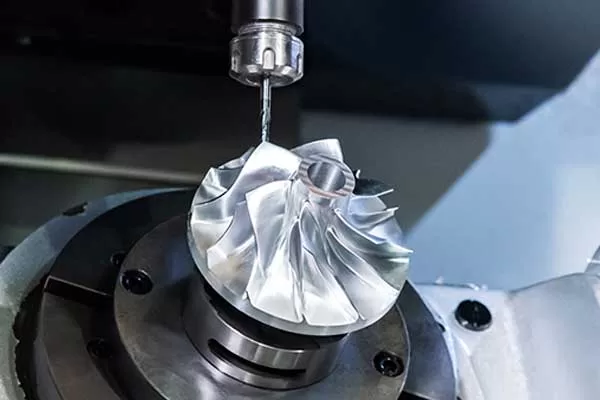5 axis-machining revolutionized the CNC process. This machine manipulates the cutting of materials through three to five axes with a high degree of precision and accuracy. After creating the CAD design, it’s translated into CNC code, programming the machine.
The 5-axis CNC machine turns and cuts parts along horizontal and vertical lines, allowing for a broad range of manufacturing applications. A 5-axis CNC machine is capable of cutting bushings, collars, inserts, fasteners, spacers, nuts, splined shafts, drive shafts and many other complex components unsuitable for manufacture with other CNC applications.

5 axis CNC machine
Applications for 5-Axis CNC Machining
Initially, 5-axis CNC machining was exclusively used to cut aerospace components due to its advanced level of accuracy and precision. However, the versatility of the cutting planes makes them suitable for many industries. 5-axis CNC machine provides a smoother finish for machined parts and greater cutting efficiency than a 3-axis CNC machine, with concise cutting cycles and less repositioning or changing of tooling.
In 3-axis CNC machining, the operator must reposition the machined components during cutting to allow the tool to cut along all faces. This interruption in the cutting process isn’t ideal and can result in issues with human error creating problems with the alignment of the cut components.
5-axis CNC machining eliminates the possibility of human error, allowing the operator and cutting tool to reach all component faces in a single operation. CAM and CAD software incorporated into 5-axis CNC machines allows for advanced component design and the creation of highly specialized parts in various applications.
Designers have the chance to incorporate advanced programming selections, including simple connections using post-processors and collision avoidance. When set up correctly, CAD and CAM programs offer machinists “lights-out” operations where they can leave the machine unattended to complete the program.
5-axis machining is ideal for creating complex three-dimensional components. It can also run traditional CNC tasks on odd or tiled surfaces. There are plenty of uses for 5-axis machining, with the following industries relying on the technology to produce a range of advanced components.
Energy Equipment
5-axis CNC machines are ideal for cutting detailed, specific components for the energy sector. When producing parts from rough, resistant materials, the 5-axis machine offers exceptional stability to the cutting surface, resulting in easy, error-free cutting. The added efficiency of a 5-axis CNC machine reduces the wear and tear of cutting tools, reducing replacement costs.
Medical Equipment
5-axis CNC machines offer medical device manufacturers optimal production processes for high-precision components like implants and surgical tools. The accuracy of the machining process allows for very fine tolerances, providing compliance with ISO and FDA standards for the healthcare industry. 5-axis machining allows for the production of highly-detailed, small components while enabling high production volumes for scalable outputs.
Aerospace Parts
As the first industry to implement a need for 5-axis CNC machining, Aerospace companies and manufacturers rely on the process’s ability to cut smooth and contoured shapes and edges. Aerospace CNC applications are typically geometrically unique and intricate, making the detailed cutting capabilities of 5-axis CNC machining ideal for the production of interior cutting on complex components. Since 5-axis CNC processes don’t require the operator to reposition the job along each pass. As a result, it’s possible to cut the entire project with a single pass.
Military Components
The military industry relies on 5-axis machining to produce advanced and precise weapons and gear manufacturing components. 5-axis CNC machines are capable of cutting elements for smart and nuclear weapon designs, submarine parts, turbines and blades, and engine and stealth components. The American government is a big buyer of 5-axis CNC machines for contracts and projects.
